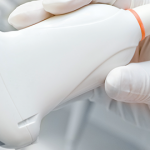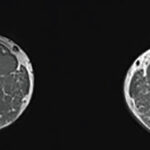As for ultrasound, color Doppler can be useful in diagnosing active inflammation in the ligamentous part of the SIJs at or posterior enthuses, but can’t pick up intraosseous inflammation. Power Doppler, more sensitive than color Doppler, gives reliable detection of peripheral enthesitis in SpA patients, Dr. Jurik said.
Multislice computed tomography (CT), she said, can be useful in cases involving subtle radiographic SIJ changes or in detection of normal variants because it gives clear delineation of spinal structures. But, she cautioned that it has less sensitivity to soft tissue and bone marrow lesions than MRI, and involves a high dose of radiation.
She stressed that the review of these techniques is ongoing. “We have to analyze the value of new imaging techniques further,” she said.
Imaging for OA
In imaging for osteoarthritis (OA), there’s a strong correlation between symptoms and pathology from MRI, but radiology is probably good enough to guide treatment decisions in a normal clinical setting, said Frank Roemer, MD, associate professor of radiology at the University of Erlangen-Nuremberg in Germany and at the Boston University School of Medicine.
Both MRI and ultrasound can guide clinicians to targeted treatment based on tissue-specific pathology and anatomic location, and MRI can predict clinical outcomes, like total knee replacement, he said.
Ultrasound allows visualization of soft tissues in multiple planes, is inexpensive, and involves no radiation. Plus, no contrast agent is needed. At the same time, though, it is user dependent, the physical properties of sound limit how widely it can be applied, and documentation is difficult with this technique.
CT, however, gives high spatial resolution and isn’t user dependent. CT-arthrography might be useful in OA assessment, he said, though it involves radiation exposure and poor soft tissue contrast.
As for usefulness in clinical trials, both X-ray and MRI are valuable tools for diagnosis and assessment of progression, although X-ray is limited in its ability to detect joint space narrowing, Dr. Roemer said.
MRI gives direct visualization of the cartilage and other OA features, such as bone marrow abnormalities, synovitis, effusion, and ligaments, and is reproducible in multicenter studies. Plus, MRI can detect OA features before they can be found on radiography. “MRI does overcome some of the limitations of radiography,” he said.
Imaging in osteoarthritis is headed toward better early targeting of OA pathology, more than just cartilage damage, along with identifying patients at high risk, or those likely to be “fast progressors,” Dr. Roemer said.

